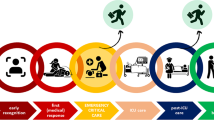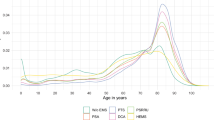Abstract
Background
Reconfiguration of the Irish acute hospital sector resulted in the establishment of a Medical Assessment Unit (MAU) in Mallow General Hospital (MGH). We developed a protocol whereby certain patients deemed to be low risk for clinical deterioration could be brought by the National Ambulance Service (NAS) to the MAU following a 999 or 112 call.
Aims
The aim of this paper is to report on the initial experience of this quality improvement initiative.
Methods
The Plan-Do-Study-Act (PDSA) Cycle for quality improvement was implemented when undertaking this project. A pathway was established whereby, following discussion between paramedic and physician, patients for whom a 999 or 112 call had been made could be brought directly to the MAU in MGH. Strict inclusion and exclusion criteria were agreed. The protocol was implemented from the 1st of September 2022 for a 3-month pilot period.
Results
Of 39 patients discussed, 29 were accepted for review in the MAU. One of the 29 accepted patients declined transfer to MAU. Of 28 patients reviewed in the MAU, 7 were discharged home. One patient required same day transfer to a model 4 centre. Twenty patients were admitted to MGH with an average length of stay of 8 days. Frailty and falls accounted for 7 of the admissions and the mean length of stay for these patients was 12 days.
Conclusions
Our results have demonstrated the safety, feasibility and effectiveness of this pathway. With increased resourcing, upscaling of this initiative is possible and should be considered.



Similar content being viewed by others
References
Royal College of Physicians of Ireland, Irish Association of Directors of Nursing and Midwifery, Irish College of General Practitioners, Therapy Professions Committee, Quality and Clinical Care Directorate, Health Service Executive (2010) Report of the National Acute Medicine Programme
Department of Health (2013) Securing the future of small hospitals: a framework for development
Higgins J (2010) Reconguration of Acute Hospital Services. A roadmap to develop an integrated university hospital network, Cork and Kerry
Oireachtas Committee on the Future of Healthcare (2017) Sláintecare Report
Taylor MJ, McNicholas C, Reed JE et al (2014) Systematic review of the application of the plan–do–study–act method to improve quality in healthcare. BMJ Qual Saf 23(4):290–298
Budd HR, Almond LM, Porter K (2007) A survey of trauma alert criteria and handover practice in England and Wales. Emerg Med J 24(4):302–304
National Ambulance Service (2023) National Ambulance Turnaround Times
Wren MA, Keegan C, Walsh B et al (2017) Projections of demand for healthcare in Ireland, 2015–2030. First Report from the Hippocrates Model
Morton R (2023) Opening statement. Joint Health Commitee
Author information
Authors and Affiliations
Corresponding author
Ethics declarations
Informed consent
This study was a retrospective audit of anonymised data collected as part of routine clinical care so informed consent was not obtained.
Ethics approval
This study was carried out in accordance with the Declaration of Helsinki and was approved by the Clinical Research Ethics Committee of the Cork Teaching Hospitals (CREC).
Conflict of interest
The authors declare no conflict of interests.
Additional information
Publisher's Note
Springer Nature remains neutral with regard to jurisdictional claims in published maps and institutional affiliations.
Electronic supplementary material
Below is the link to the electronic supplementary material.
Appendix
Appendix
Revised inclusion criteria
-
1.
Ceiling of care established and patient not for escalation of care to ICU
-
2.
Low risk medical patients with stable vital signs including, but not limited to the following:
-
Vasovagal syncope
-
Non-cardiac chest pain
-
Gastroenteritis
-
DVT
-
Musculoskeletal pain
-
-
3.
Patients known to MGH who have had a recent admission will also be considered if appropriate
Rights and permissions
Springer Nature or its licensor (e.g. a society or other partner) holds exclusive rights to this article under a publishing agreement with the author(s) or other rightsholder(s); author self-archiving of the accepted manuscript version of this article is solely governed by the terms of such publishing agreement and applicable law.
About this article
Cite this article
O’Flynn, A.M., Hart, C., Munoz-Claros, A. et al. New care pathway to enable ambulances transfer patients to a model 2 hospital medical assessment unit. Ir J Med Sci 193, 3–8 (2024). https://doi.org/10.1007/s11845-023-03438-y
Received:
Accepted:
Published:
Issue Date:
DOI: https://doi.org/10.1007/s11845-023-03438-y




